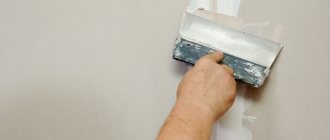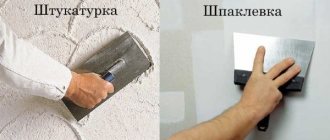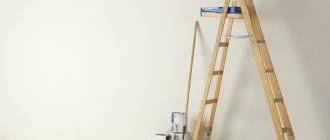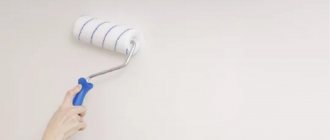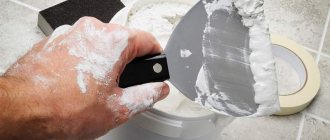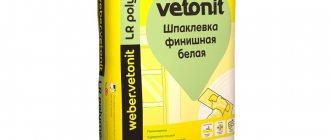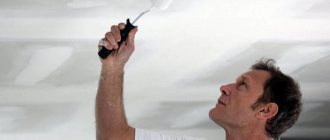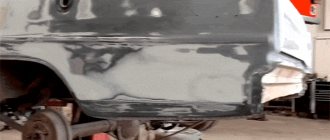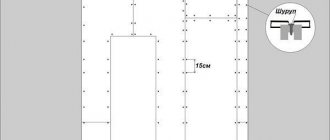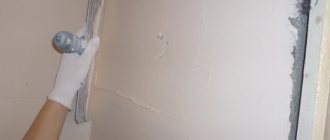Preparatory work
Before starting work, the question naturally arises: how much putty will be needed for repairs and what determines its consumption? Let’s say the work is coming to an end, but in the end it turns out that there wasn’t even enough putty. Or another situation: the putty is done by a work team, which will provide you with an inflated estimate when you have to buy extra. To avoid getting into such situations, you need to understand the specifics of rationing building materials.
The consumption of putty primarily depends on its type: each type of putty is consumed differently. You also need to take into account the condition of the surface being treated, which affects the thickness of the putty layer. Among other nuances that affect the consumption of material, one can highlight the correct preparation of the mixture, as well as the quality of applying the putty.
Now there are three basic types of putty, on which the consumption rates of building materials directly depend: starting, universal and finishing.
A painter applies putty to the ceiling in an apartment
Basic calculation
The main material for initial putty is gypsum. The rate of putty consumption per 1 m² on perfectly smooth walls is 0.9 kg/m². If we see obvious curvature, the norm will be 8 kg/m2
It is important to understand that the initial finishing should be carried out in a thickness of no more than ten millimeters to avoid destruction. The consumption of finishing putty per 1 m² of plaster, which is applied at the end, is up to 1 kg/m², the layer is thin up to one millimeter
Please note that before purchasing, you need to familiarize yourself with the details and nuances from the manufacturer. It is quite possible that all the information of interest will be in the instructions, where you can find the properties of the product and its application. Be sure to review before use.
In order not to make mistakes in the calculations, it is necessary to carry out the following calculations: multiply the numbers from the packaging by the surface area and add another ten percent. The sequence looks like:
- find out the data of the factory box;
- We calculate the area of the walls (multiplying the length by the width);
- add 10% to the result obtained.
In the specialized literature, as well as on the Internet on various resources, there are tables with types of putties and their average consumption per 1 m². One more rule should be observed: the initial and final putties should be applied in a ratio of approximately 2:1. If the initial value is 6 mm, then the finishing value will be 3 mm.
Undoubtedly, the option with ready-made putty is very convenient. This is a diluted substance that does not require additional effort to dilute. It is worth noting that this mixture is better than all kinds of other dry building materials, being a good way to avoid cracking.
What affects consumption?
The consumption of putty material largely depends on its purpose. For example, finishing putties are applied in a thin layer, so the costs of such mixtures are not too high. But the base solution performs the function of leveling larger defects, and therefore significantly more material is consumed. Consumption standards also differ depending on what type of surface is being treated: more putty is needed for the floor, less for the ceiling.
The nature of the surface is of great importance. If there are a lot of depressions, cracks, and height differences on the wall, then much more leveling material will be used on such a surface than on a flat coating with minor defects.
The skill of the performer also plays an important role. An experienced worker, all other things being equal, will always spend less putty than a novice builder. After all, an experienced person has a “hands full”; he has encountered such tasks before. In addition, beginners make more mistakes when doing work, leaving uneven places, which then have to be further trimmed, wasting putty.
The air temperature, its humidity, as well as the quality of the batch produced have a certain influence.
The correct amount of work also affects the putty consumption. There are often situations when, due to incorrect calculations, excess mixtures already prepared from dry powder have to be thrown away.
Note! Any theory must be tested by practice. The information on the packaging on solution consumption represents a certain average value, without taking into account many variables that can significantly affect the final figures.
What determines the consumption per square meter?
Wall putty is currently carried out using various materials. The material of the walls, of course, directly affects its consumption. Walls can be made of any material. It is also worth remembering that putty is used not only for finishing walls, it is also used for application to other surfaces. It is often used for restoration.
The material is almost always applied in two layers. The first one is the starting one. It serves to level out various surface defects. Then the finishing putty is applied to the wall. It serves to directly level the surface and create a layer onto which paint and other materials can be applied. Ready-made putty is often used to level ceilings, walls, etc. It is more convenient to use, but at the same time it costs much more than the one that has to be mixed.
Very often, when people start thinking about plastering walls, they invite third-party workers, and sometimes entire work teams. Often, estimates indicate more putty than is actually required.
This is worth paying attention to when purchasing. Of course, it is better to independently calculate the plaster consumption per square meter and do all the work yourself, but not everyone can do this
The amount of material depends not only on what type is used to cover the walls
It is very important to think about how curved the surface on which the material will be applied is. If there are many defects on it, then much more material will be required than to work with a flat surface.
That is why it is almost impossible to calculate the mixture rate exactly down to the kilogram. You can always only make an approximate calculation of its quantity for a particular surface and material.
Features of putty and plaster
Many inexperienced “repairers” are often interested in the question: “How is plaster different from putty?” There are no fundamental differences, but there are features that are important to consider when finishing.
| plaster | putty | |
| What is this? | mortar | |
| compound | sand cement plasticizers (fillers) REFERENCE: Plasticizers are special substances that give the solution viscosity, plasticity and mobility. | |
larger fillers:
| finer fillers:
| |
| structure | more granular due to coarse mineral filler | more homogeneous |
| what is it used for | surface leveling:
| elimination of minor defects:
|
Based on the data in the table above, it becomes clear what is the difference between the two building mixtures. Plaster is suitable for repair work that requires applying more than 1 cm of mortar for leveling. Putty is suitable for smaller irregularities and damage on the walls.
REFERENCE: Plaster is much cheaper in price than putty. At the same time, it is much stronger than putty and is applied in a thicker layer.
Types of material
There are several types:
- external putty;
- Vetonit putty (for rooms with low humidity);
- oil and glue based material;
- gypsum-based substance;
- final puttying;
- Shitrok putty.
Often a list of necessary things is compiled, which are more than usual. In order to avoid unnecessary expenses, it is necessary to correctly calculate the substance. This way you can save money and avoid unnecessary amounts of putty.
Correct calculations of building materials directly depend on the condition of the working surfaces, unevenness, and other curvature. Therefore, we present the consumption rates below.
Putty consumption per 1 m2 - table
| Brand | Consumption per kg/m2 |
| Putty UNIS KRON / UNIS KRON Polymer | 1 |
| Putty UNIS LR Plus / UNIS LR | 1 |
| Putty Farvest SMEO-02 Universal | 0.8 |
| STARATELI base putty | 1 |
| STARATELI façade putty | 1 |
| Finishing putty STARATELI | 0.9 |
| Finishing putty STARATELI | 0.9 |
| Putty RUSEAN TT Facade | 1 |
| Putty OSNOVIT VERSILK T-34 gypsum gray | 0.9 |
| Putty OSNOVIT ELISILK T-36 gypsum superthin | 1 |
| Putty OSNOVIT BAZSILK PC 30 MG | 1 |
| Putty OSNOVIT BAZSILK T-30 | 1 |
| Putty OSNOVIT LERSILK T-37 | 1 |
| Putty OSNOVIT ECONSILK PG35 W | 0.85 |
| OSNOVIT GLEDSILK T-38 polymer putty | 1 |
| Putty OSNOVIT BELSILK T-32 cement white | 1.2 |
| Putty OSNOVIT GRAYSILK T-31 cement gray | 1.3 |
| Putty VETONIT FINISH KR / VETONIT FINISH KR white | 1.2 |
| Putty VETONIT FINISH LR PLUS / VETONIT FINISH LR PLUS | 1.2 |
| Putty VETONIT WEBER VH / Weber Vetonit VH white | 1.2 |
| Putty VETONIT WEBER VH / Weber Vetonit VH gray | 1.2 |
| Putty VETONIT FINISH LR PLUS / VETONIT FINISH LR PLUS | 1.2 |
| Finishing gypsum putty LITOKOL LITOGIPS FINISH / LITOKOL LITOGIPS FINISH for interior work | 1 |
| Putty LITOKOL LITOFINISH FINE / LITOKOL LITOFINISH FINE finishing polymer | 1 |
| Putty LITOKOL LITOFINISH FASAD / LITOKOL LITOFINISH FASAD mixture based on white cement | 1.3 |
| Putty KERAFLEKS KR55 Elite | 1.1 |
| Putty Volma Finish gypsum | 1 |
| Volma SHOV gypsum putty for sealing gypsum plasterboard, gypsum board joints | 0.8 |
| Bolars leveling putty | 1.4 |
| Bolars gypsum finishing putty for interior work | 1 |
| Bolars façade finishing putty | 1 |
| Putty PUFAS GLATT UND FULL SPACHTEL / PUFAS GLETT AND FULL SPACHTEL No. 3 finishing thick layer | 1 |
| Putty PUFAS GLATT UND FULL SPACHTEL / PUFAS GLETT AND FULL SPACHTEL No. 3 finishing thick layer | 1 |
| Putty PUFAS FULL+FINISH / PUFAS FULL+FINISH gypsum for interior work | 1 |
| Putty PUFAS FULL+FINISH / PUFAS FULL+FINISH gypsum for interior work | 1 |
| PERFEKTA / PERFEKTA SUPERFINISH gypsum putty | 0.9 |
| PERFEKTA/PERFECTA EKOSTART gypsum putty | 0.9 |
| PERFEKTA / PERFEKTA EKOFINISH gypsum putty | 0.9 |
| PERFEKTA / PERFECTA ECOKRAFT gypsum universal putty | 0.9 |
| Superfinish polymer putty PERFEKTA / PERFECTA ULTRAFINE | 0.9 |
| PERFEKTA/PERFECTA GLIDE PREMIUM cement putty | 1 |
| PERFEKTA/PERFECTA GLIDE STANDARD cement putty | 1 |
| PERFEKTA / PERFECTA START GLIDE cement base putty | 0.9 |
| Putty KNAUF FUGEN / KNAUF FUGEN | 0.8 |
| Putty KNAUF MULTI-FINISH / KNAUF MULTI-FINISH | 1.2 |
| Putty KNAUF Polymer Finish / KNAUF Polymer Finish | 1.2 |
| Putty KNAUF UNIFLOT / KNAUF UNIFLOT | 0.4 |
| Putty KNAUF UNIFLOTT / KNAUF UNIFLOTT | 0.4 |
| Putty HENKEL CERESIT CT127 / HENKEL CERESIT CT127 | 1.2 |
| Putty HENKEL CERESIT CT225 / HENKEL CERESIT CT225 finishing | 1.8 |
| Putty GLIMS Finish Light Room + / GLIMS Light Room + | 1.2 |
| Putty BERGAUF Fugen Gips / BERGAUF Fugen Gips Universal | 1 |
| Putty BERGAUF Finish Plast / BERGAUF Finish Plast | 1.3 |
| Putty BERGAUF Finish Polymer / BERGAUF Finish Polymer | 1 |
| Putty BERGAUF Finish Zement / BERGAUF Finish Cement | 1 |
| Putty BERGAUF Glatte Zement / BERGAUF Glatte Cement | 1 |
| Putty BERGAUF Finish Gips / BERGAUF Finish Gypsum gypsum | 1 |
| Putty BERGAUF Finish Polymer / BERGAUF Finish Polymer based on a polymer base | 1 |
Consumption rate of putty for plaster per 1 m2
Plastering and puttying are the main operations that prepare the surface for wallpapering or painting. The general scheme of work is as follows:
- plastering
- puttying
- grinding
- painting/wallpapering
Thus, putty is the final preparatory operation.
A pre-plastered wall should not have major defects. The putty is applied in a layer not exceeding 1 cm.
The total coating layer should not exceed 3 cm, otherwise there is a risk that the applied materials will crack and crumble.
If the wall is smooth, then applying a putty mixture 1-2 mm thick is sufficient. In this case, the consumption of putty on plaster per 1 m2 is from 800 to 900 g per m2. However, in the presence of cracks, chips and other irregularities, consumption increases up to 10 times.
What factors can affect material costs?
The larger the surface, the more consumables you will have to purchase. All manufacturers indicate consumption per 1 m2 on the label. But this figure is approximate and depends on other characteristics. The area of work is not the final factor for calculating costs.
The following factors influence material costs:
- Surface quality. Various defects in the form of microcracks, roughness, scratches. Their depth and the curvature of the surface itself are important. The better, smoother and without significant defects the surface, the less construction mixture will be required for work.
- Base material. A brick or plaster wall will require more mixture.
- Place of puttying work and selection of suitable material. In humid environments, you should work with cement mortars. External work must also be carried out with them. Apply in a thick layer. Gypsum mixture is quite economical in consumption, while cement compositions are consumed more actively.
- The employee's experience and qualifications. Professionals not only cope with the task in a shorter time, but they also know how to use less building materials. With experience comes the ability to save.
- The result that is planned to be achieved. If a layer of putty is applied for further finishing, then it must be applied more efficiently, using a larger volume of the mixture. If puttying is the final stage, then the consumption depends only on the curvature of the walls and the elimination of irregularities.
- Type of putty material (finishing, starting or universal). The result of the calculated volume depends on it.
Important
On a smooth surface it is enough to apply 1–2 mm. If there are defects, the flow rate can be increased up to 10 times depending on the characteristics.
Starting putty - consumption per 1 m2.
For initial leveling of the base, starting putty is used. It is applied as an intermediate coating between plaster and finishing putty. At the same time, the starting putty contains a rather coarse fraction in its composition, since it is most often based on gypsum or lime. Therefore, its consumption will be the greatest. Starter putty is sold in paper packages of 25 and 30 kg.
The consumption of the starting putty composition usually averages 1.0-1.4 kg per “square” of base with a layer of 1 mm. This information is provided in more detail in the instructions.
Practice has proven that one standard 30 kg bag of any starting putty with minimal unevenness, and even under a painting mesh, is quite enough for 10-20 square meters. m walls.
But if the walls are in poor condition and not leveled, then the consumption of the putty mixture will increase. For example, if the layer of starting putty is planned to be 5 mm, then its consumption will increase to approximately 4-8 kg per square meter. m.
Features of starting putty consumption
An important point should be taken into account: it is not recommended to apply a starting putty composition thicker than 5-10 mm in one pass, otherwise it may crumble in the future. The description for any putty usually indicates the minimum and maximum allowable layer level at a time.
For example, for “Polimin ShG-11” putty, the calculated thickness at a time is taken to be no less than 3 mm, but not more than 10 mm. Composition yield: 1.05 kg per “square” with a layer of 1 mm.
COST OF APPLYING 1 M2 OF PUTTY
But “SATYN PW-01” putty has a maximum permissible layer thickness of 8 mm, consumption per sq. m. is 1.3 kg.
The instructions for the starting polymer-cement putty “Ceresit CT 29” indicate that the thickness of application of one layer varies from 2 to 20 mm, and in fact, the consumption of this mixture per square meter. meter is 1.8 kg with a millimeter layer
ADVICE! To minimize the cost of building materials and not exceed acceptable limits, it is advisable to study the surface in advance and, if necessary, plaster old, rough and uneven walls.
By the way, as an initial leveling composition, you can also choose the popular “Knauf HP Start” starting mixture based on lime and gypsum. It is very convenient and is suitable both as plaster and as a starting putty. The stated limits of the coating are 1-3 cm. With a mortar thickness of 10 mm, a 30 kg packet of mixture is enough for 3.8-4.0 sq.m.
Consumption rates for ready-made putties
Ready-made putty material is a mixture that is a thick consistency, ready for putty. It is usually used to level ceilings against smooth walls or restore carpentry. It is sold in plastic buckets. Such mixtures are an order of magnitude better in quality than dry ones, since they contain substances that give the putty special properties (increasing adhesion, reducing cracking). Although such mixtures are much more expensive, their price is justified by their quality.
Today, the Shitrok mixture is in particular demand. Experts like it for its cost-effectiveness. Its costs with a thickness of 1 mm will be equal to 0.5 kg/m2. Craftsmen appreciate its ease of use, quick drying, and the absence of asbestos and drying cracks.
In addition to this mixture, today Knauf, Pufas and Ceresit are readily used when carrying out repair work. Their consumption can range from 1.5 to 1.7 kg/m2. The consumption of Vetonit putty with a layer thickness of 1 mm is 1.2 kg/m2.
Table of consumption rates for some types of putties
When preparing for finishing work, remember that their quality depends on the correct choice of material, including putty. When choosing it, consider the quality and nature of the surface. Know that at different stages of work you need different amounts of mixture. If the wall is flat, then the starting putty will need about 1 kg/m2 with a thickness of 1 mm, and the finishing putty 0.5 kg/m2 with a thickness of 0.5 mm. As the layer increases, the consumption will also increase. One layer of putty is rarely needed. The second layer will be thinner. Do not forget that ready-made mixtures are of higher quality and more economical. Remember that you need to add a little extra to the calculated volume of the mixture, because a minimal amount will remain on the spatula and bucket.
Preparatory work
In order to get a high-quality result at the end of the putty work, you need to carefully prepare for this process.
1. Preparation of the base (ceiling or wall):
- must be durable
- dry
- clean
- without peeling
It is necessary to remove dirt, plaque, plaster residues, wallpaper, looseness, oily inclusions, etc.
The wall or ceiling should not be wet or frozen. Before puttying, be sure to dry the base.
2. Preparation of the workplace. Since the process of leveling walls is a dusty and dirty job, it is necessary:
- cover the floors with newspapers or special film
- It is better to remove decorative items and furniture; if this is not possible, then also cover with film
3. Preparation of tools. You will need a drill with a special attachment (or something you will use to mix the dry mixture manually), spatulas, a container for the composition and a level (if you have to work on leveling the walls/ceiling). All equipment must be clean and dry.
The tool must be washed thoroughly immediately after use, otherwise it may only end up in the trash.
4. Preparation of the building mixture (read more about this below).
Subtleties of application
Tools for applying Sheetrock putty:
- spatulas (width – 12.20-25 cm);
- Sheetrock Joint Tape;
- sponge;
- sandpaper.
The finishing coat must be applied to a prepared surface that has been previously treated with putty for leveling, plastered or sanded. The surface should not have unevenness or cracks. The first layer of putty must be applied to completely dry plaster, otherwise mold will form over time. A small amount of putty is scooped onto a wide spatula, then spread in an even layer over the entire area of the wall or ceiling.
Next, you need to let the first layer dry. The next layer is applied only on the completely dry previous layer. To obtain an ideal surface condition, experts recommend grinding each layer of putty using an abrasive mesh with a grain size of 180-240 units. The maximum number of layers is 3-4. After all work, the treated area is cleared of dirt and dust.
If necessary, you can dilute the composition with water, but you need to add it in 50 ml portions, followed by stirring. A large amount of water will only worsen the adhesion of the solution to the surface, but the resulting result will not give the desired effect. It is prohibited to mix the putty mixture with other materials. The frozen putty mixture must be stirred to a uniform consistency without lumps or air bubbles.
To prevent the applied finishing material on the walls from freezing, it is recommended to cover it with a thermal insulation coating (foam plastic). At the end of finishing, the putty remaining in the container must be tightly closed with a lid. Store at room temperature.
Sealing seams with Sheetrock putty:
- seal the seams (trowel width – 12 cm);
- install a tape in the center that needs to be pressed into the wall;
- excess putty mixture must be removed and applied in a thin layer to the tape;
- puttying screw heads;
- after the first layer has completely hardened, you can proceed to the second. For this, a spatula 20 centimeters wide is used;
- give time for the second layer of putty to dry;
- Apply a thin layer of finishing putty (trowel 25 cm wide). The same layer is applied to the screws;
- If necessary, smooth the seams with a sponge soaked in water.
Finishing internal corners:
- cover all sides of the tape material with putty;
- the tape is folded lengthwise in the middle, pressed against the corner;
- get rid of excess mixture and apply a thin layer to the tape;
- give time to harden;
- applying a second layer to one side;
- drying;
- applying 3 layers on the second side;
- give time to dry.
Finishing external corners:
- fixing a metal corner profile;
- applying three layers of putty with pre-drying. The width of the second layer should be 10-15 cm larger than the previous one (the width of the spatula is 25 cm), the third layer should slightly extend beyond the previous one.
Texturing:
- Apply Sheetrck putty to the required area with a paint brush;
- texturing technology using special tools (paint roller, sponge and paper);
- Drying time is about 24 hours at air humidity of 50% and temperature + 18 degrees.
Sanding putty:
- To carry out the sanding work you will need a sponge and sandpaper.
- A sponge moistened with water is wrapped in paper. This is necessary to ensure that less dust is generated.
- Sanding is carried out with light movements along the resulting irregularities.
Review of the most famous and used putties
If you try to count all the types of putties that are available in a good construction hypermarket, it will take at least several hours. And if you try to study all the technical characteristics, it will take much more time. Therefore, it was decided to give a short overview in the form of a table, which presents putty mixtures from the world's leading manufacturers, the quality of which has been tested by time.
| Image | Name, packaging | Purpose and description | Thickness of applied layer | approximate price |
| KNAUF Rotband-Finish gypsum putty , packed in 20 kg and 25 kg bags. | Apply over gypsum, cement plasters or plasterboard sheets to prepare for a quality finish. | 0.2-5 mm | 400 rubles per 25 kg bag. | |
| Gypsum putty KNAUF-HP Finish , packed in 25 kg bags. | For filling surfaces with a solid base indoors with normal humidity levels. | 1-3 mm | 270 rubles per bag of 25 kg. | |
| KNAUF Multi-finish gypsum finishing putty , packed in 25 kg bags. | For filling surfaces with a solid base, as well as thin-layer plastering (3-5 mm) indoors with normal humidity levels. | 0.15-5 mm | 400 rubles per 25 kg bag. | |
| Ready-made finishing putty KNAUF Rotband – Paste , packaged in buckets of 5 kg and 20 kg. | For finishing puttying of plasterboard sheets, as well as surfaces plastered with gypsum or cement plasters. After application, the surfaces are ready for a high-quality finish. | 0.1-3 mm | 650 rubles per 20 kg bucket. | |
| Ready-made putty mixture KNAUF Multi-finish paste , packaged in 5 kg and 20 kg buckets. | For sealing joints of plasterboard boards and other sheet materials, puttying any surfaces: plastered, concrete. After treatment, the surfaces are ready for painting, gluing and applying decorative plasters. | 0.1-3 mm | 700 rubles per 20 kg bucket. | |
| Cement facade putty KNAUF Multi-finish , packed in 25 kg bags. | For high-quality leveling of concrete surfaces and cement plasters both outside and inside – in rooms with high humidity, as well as for filling holes and sealing cracks. | 1-3 mm | 350 rubles per 25 kg bag. | |
| KNAUF-Rotband Paste Profi , ready-made paste-like finishing putty on a vinyl base. Bucket packaging: 5 kg and 18 kg. | For finishing putty (for stripping) of any surfaces (except wooden) for painting, wallpapering, or applying any other high-quality finishing materials. | Up to 2 mm | 800 rubles per 18 kg bucket. | |
| Ceresit CT 127 . White finishing polymer putty for interior work, packed in 25 kg bags. | For filling minor defects and finishing leveling of any hard surfaces inside buildings. After use it can be painted or wallpapered. | Up to 3 mm | 550 rubles per 25 kg bag. | |
| Ceresit CT 95 . Ready-made white finishing polymer putty, packaged in 5 kg and 25 kg buckets. | For use on any hard surfaces (except wood) indoors. After sanding, the surface is as smooth as possible, ready for any finishing. | Up to 3 mm, in one pass the layer thickness should not exceed 1.5 mm. | 1300 rubles per 25 kg bucket. | |
| Weber.vetonit LR+ . Finishing white putty with a polymer binder, packed in 5 kg and 25 kg bags. | For finishing leveling the surfaces of walls and ceilings indoors with normal humidity before painting or wallpapering. | 1-5 mm | 660 rubles per bag of 25 kg. | |
| Weber.vetonit KR . Finishing white putty with an organic binder, packed in 5 kg and 20 kg bags. | For application to plastered surfaces, plasterboards (except seams). | 1-4 mm | RUB 399 per 20 kg bag. | |
| Weber.vetonit VH . Finishing cement putty, moisture-resistant, white, packed in 5 kg and 20 kg bags. | For external and internal works. Can be applied to cement plasters, concrete, foam concrete, brick, plasterboard sheets. | 1-3 mm | 490 rubles per 20 kg bag. | |
| Weber.vetonit LR Fine . White super finishing polymer putty, packed in 25 kg bags. | For super-finish leveling of walls and ceilings indoors. | 0.5-3 mm | 680 rubles per 25 kg bag. | |
| Weber.vetonitJS . Universal white polymer putty, packed in 5 kg and 20 kg bags. | For leveling old painted surfaces, finishing leveling before painting or wallpapering. | 1-2 mm | 630 rubles per 20 kg bag. | |
| Sheetrock All purpose joint compound , universal polymer-lime putty with a vinyl-based binder, packaged in 5 kg and 28 kg buckets. | For interior work, used in rooms with normal humidity. Can be applied to almost any hard surface except wood. Excellent for sealing drywall joints. Sands beautifully and the finished surface is ready for any high quality finish. | Up to 2 mm | 1100 rubles per 28 kg bucket. |
The data in the table is quite enough to evaluate what putties exist, since everything from other manufacturers is very similar. The given compositions of these particular brands in no way detract from the merits of others, but simply give a general idea.
Ways to solve the problem
Most often, finishers use the time-tested method of laying a trial plot. Select one small part of the wall, which is conventionally taken as the standard. A full range of work is carried out on it. Primer, plaster and subsequent putty. The exact consumption of materials per 1 m2 is calculated and compared with the data provided by a standard calculator.
By drawing up a simple mathematical proportion, an error coefficient is derived, which is subsequently used to work on leveling all other walls. This method makes it possible not to exceed an error of 2-3% in further calculations. Thus, the consumption of plaster becomes more predictable when purchasing materials.
If the wall plastering is done efficiently, the calculation of putty consumption should practically not differ from the data provided by the calculator. Increased consumption of putty occurs mainly when the walls are not leveled enough and it is necessary to level this out with putty. In such cases, the consumption of putty per 1 m2 can reach the most unexpected levels.
The optimal option is when plastering and putty are carried out by one person or one team. Then responsibility for the final result cannot be shifted to the mistakes of the previous performer. This is another point, already organizational, but the consumption of plaster also depends on it.
High-quality leveling of walls and preparing them for further painting or wallpapering is the most important condition for performing all subsequent stages of construction or repair.
It is very difficult to stick wallpaper well to uneven walls: the edges of the sheets may not match due to the geometric curvature of the surface. The lighting in the room will be uneven, as the bumps and depressions will create shadows. Highlights and partial shadows form on the ceilings. Installation of furniture and wall equipment becomes more difficult.
In addition, the consumption of plaster is significantly affected by the selection and quality of materials used in the work, and their storage conditions.
For example, cement mixtures give, although small, but noticeable shrinkage, a greater number of roughnesses and cellular formations on the surface of the wall. This, in turn, leads to the fact that the consumption of putty per 1 m2 of plaster will be overestimated.
Such mixtures are used mainly for plastering the external walls of buildings, as well as in rooms with high humidity. There is absolutely no need to cover the walls of interior and living spaces with cement plaster.
Plasters based on gypsum, chalk or lime are smoother and do not shrink. They are produced in the form of dry mixtures and are convenient for transportation. They are well polished and processed to the required condition. In addition, many of the manufacturing companies add synthetic plasticizers to such mixtures, which makes these mixtures more elastic and resistant to mechanical damage.
Using tables or a calculator to calculate the consumption of plaster and putty when using such materials is more justified and appropriate.
And finally, the consumption of plaster directly depends on the professionalism of the craftsmen performing the work.
A scrupulous customer should always remember that a good master is more expensive than a beginner. But in the end, betting on skill always pays off handsomely. Confirmation of this will be the consumption of plaster.
Dependence of putty consumption on surface type
When planning to putty a wall, you need to take into account the nuances associated with the properties and texture of different types of surface.
- The putty does not fit well on a concrete wall. To increase adhesion, it is necessary to treat the wall with a concrete contact primer. The putty layer should not exceed 6 mm.
- Working with drywall involves using both a starting and a finishing layer, despite the apparent evenness of this material. At the same time, the consumption of putty per 1 m² of drywall is less than, for example, for a brick wall. For special gypsum putty this is approximately 0.85 kg per m².
- Wood is not able to hold a thick putty layer. Therefore, even taking into account the preliminary application of a contact primer, the layer of starting putty should not exceed 2-3 mm, and the second layer - even less.
- The painted wall must first be completely cleaned of paint (scraped off or washed off in the case of a water-based emulsion). If it was not possible to completely get rid of the paint, you need to make cuts in the wall at intervals of 5 cm, which will increase the adhesion of the coating to the surface. In this case, it is allowed to apply a starting putty with a thickness of 3-7 mm and a finishing putty of no more than 3 mm.
[vimeoyoutubepopup_video displaytype=”image” videoplayer=”youtube” videoid=”P4tyyrxueM8” text=”How to putty walls” autoplay=”true”]
Types of putty
First, let's get acquainted with the types of putty mixtures.
Starting. Used for initial leveling of the wall surface. It has a coarse-grained structure. The main requirement for it: high levels of adhesion (adhesion to the surface) with uneven application (due to the presence of depressions and irregularities). This roughing product should be selected taking into account the humidity and temperature of the room, as well as the type of material from which the walls and ceilings are made. Usually it is applied in a layer of 3-6 mm.
Finish. Used as the last layer before painting or wallpapering. Thanks to its fine-grained composition, it corrects the smallest imperfections in the wall and makes it perfectly smooth for subsequent finishing. When choosing a finishing putty, you should pay attention to the size of the fraction (the smaller the better) and the compatibility of its composition with wallpaper or paint (otherwise there is a risk of swelling, stains, peeling, bubbles and shrinkage). A type of finishing putty is its improved version - Shitrok putty. The vinyl fibers included in the composition significantly increase performance characteristics.
Universal. The name speaks for itself: the material is suitable for both starting and finishing work. Has medium-grained fractions. With average quality wall leveling is not cheap. Suitable for small amounts of work that do not require special qualifications.
Vetonit. Brand of finishing putties, divided into polymer, cement and gypsum. The binder base of this mixture is polymer glue, cement, gypsum or limestone. They are used both for interior work and for facade processing. Its advantages include:
- fineness;
- environmental friendliness;
- moisture resistance, due to which they can be used even in bathrooms;
- frost resistance.
The disadvantages include the considerable consumption of Vetonit putty, ranging from 1.2 to 1.4 kg per m² of surface and the lack of decorative properties. Therefore, this putty cannot be used as an independent decorative coating and needs to be finished with paint or wallpaper.
Vetonit is a well-known brand of finishing putties
Adhesive. Contains a 10% adhesive solution, chalk and drying oil. Thanks to this, it has increased adhesion, strength and elasticity. Suitable for subsequent whitewashing or finishing with oil and water-based paints.
Oil-glue. It differs from adhesive in a higher percentage of oil and the presence of acrylates, cellulose derivatives and plasticizers in its composition. Used for interior work only. Its advantages include:
- cheapness;
- durability;
- practicality.
However, it is not without its drawbacks:
- impossibility of use for facades, floors, bathrooms and other rooms with high humidity;
- not environmentally friendly.
[v[vimeoyoutubepopup_video displaytype=”image” videoplayer=”youtube” videoid=”MXoOczGwo5w” text=”How to calculate putty consumption” autoplay=”true”]p>
How to calculate
Finding out the required amount of material is not so difficult; for calculations you will need the following information: the perimeter of the room, the height of the walls, the thickness of the applied material. Following this algorithm, you can find out the required amount of material per 1 square meter. m.:
- The standard for building material consumption per 1 m² is multiplied by the thickness of the putty.
- The length of the wall is multiplied by the height, and the height of the walls is added to the resulting number.
- The number obtained in step 1 is added to the perimeter of the room.
- This number is then multiplied by the value obtained in step 2.
A bag of putty is enough in different ways - it all depends on the condition of the walls, as well as the number and thickness of layers of material applied.
| Average consumption per 1 m², kg |
It is impossible to calculate the putty consumption per 1 m² of wall, indicating the exact amount of material used; the result will always be approximate. When purchasing, it is recommended to read the manufacturer's instructions indicated on the package.
How to calculate putty consumption?
Correct calculation of the mixture consumption for puttying is impossible without taking into account the thickness of the layer, the type of putty and the type of surface, as well as average standards derived empirically by specialists.
Average consumption of various putty mixtures
A table will help you calculate the amount of putty, which shows the weight of some types of mixture required to treat one m² of area.
| Starting | Finish | Plaster | Adhesive | Oil-adhesive | Shitrock | Vetonit |
| 1.8 kg | 0.44 kg | 0.85 kg | 0.47 kg | 3 kg | 1 kg | 1.18 kg |
An example of calculating putty consumption for room walls
The consumption of putty for a room is calculated according to the formula
R= N* k (( L1+L2+L3+L4)*H+(L5*H1))
- N – consumption rate per 1 m²,
- L1,L2,L3,L4 - the length of all internal walls in the room (excluding the doorway),
- H is the height of the walls,
- L5 - length of the wall above the doorway,
- H1 - height of the wall section above the door opening
- k is a correction factor that takes into account the thickness of the layer and the increase in consumption due to a large number of irregularities on the wall, drying of part of the putty on the walls of the bucket and the spatula during operation.
For example, let’s calculate the maximum consumption of Vetonit putty for a room with a height of 2.8 m and walls length L1=3 m, L2=2 m, L3=3 m, L4=2 m, L5=1 m, H1=0.8 m. Let's take the coefficient equal to 1.5.
R= 1.4*1.5((2+3+2+3)*2.8+(0.8*1))=59.6 kg
The total consumption of material depends on the area of the surfaces to be finished.
Calculator for calculating mixtures for different types of surfaces
Using a calculator you can calculate the approximate consumption of putty per unit of measurement - 1 m2. A margin of 10% is added to it. It is necessary to take into account separately entered indicators (length and width of the measured surface), base material.
Concrete surfaces absorb a significant amount of moisture due to their porous structure. Therefore, it is necessary to include an additional indicator in the calculation calculator, which will then be increased by at least 0.5. Concrete does not need a thick layer, but the consistency of the composition is important.
If we take a brick base, it is similar to concrete and requires significant costs for absorption. Water must be added several times more than for smoother surfaces. If bases made of other materials are puttied, then the calculation calculator will be approximately the same as conventional calculations. The quantity should also include a reserve of 10% in case of unforeseen expenses.
Ready-made building materials
We also recommend using Shitrok putty, which can be applied to walls in a thin layer of up to 0.5 kg/m² with a thickness of up to 1 millimeter. It has the following advantages:
- simplicity and comfort in work;
- quick drying;
- goes well with drywall;
- does not contain asbestos;
- no cooking required.
We emphasize that putty is poorly applied to concrete surfaces. And if you still had to cover them, use a concrete primer or take a regular one.
If you are working with painted walls, you should remove as much of the previous substance as possible. Some types of paints, such as those based on water emulsion, can be washed off.
When working with wood, the layer should be small. Apply concrete primer. It is she, like no one else, who will allow you to apply a thin layer of the substance.
These simple recommendations will allow even beginners to use putty per 1 m². Follow the above rules and you will succeed. Do not apply too thick layers, experiment, make the interior comfortable for you. Choose a substance that is most comfortable to work with; it may or may not be ready-made putty.
Useful tips
Puttying is carried out in several layers using various types of putty: leveling, finishing, universal. Each material will have different recommendations.
First, a leveling compound is applied to the wall; it is done in two layers, but before applying the second, you must make sure that the first is completely dry. It is not recommended that the putty thickness exceed 16 mm.
Failure to comply with this limitation may result in defects on the surface. The recommended value is 11 mm; to apply this thickness, the consumption of basic putty per 1 m² of wall is 1 kg.
The finishing should be done on top of the leveling one, the work is carried out carefully, because the putty is applied in a small layer. Material consumption is low, approximately 0.7 kg per m².
Universal putty is applied both to eliminate significant wall defects and for general leveling. The average consumption of putty per 1 m² of wall is about 0.8 kg.
Our channel in Yandex Zen: zen.yandex.ru
Post Views: View statistics 232
Types of putties and scope of application
The main criterion for classifying putties is their scope of application:
- Leveling - this type is designed to eliminate significant unevenness on the wall or ceiling. Most often it is applied to bare brick, as well as concrete. The peculiarity of this material is that it has a coarse-grained structure, dries quickly and is practically impossible to process. Leveling putty is difficult to apply in an even layer, and wallpaper cannot be glued to it.
- Finishing - it is applied over the leveling layer in a thin layer, approximately 0.4-0.5 cm. Preparing surfaces for finishing is possible due to the fine-grained structure of the material.
- Universal - the material can be applied to walls or ceilings both during leveling and finishing. It is distinguished by high quality and durability. Thanks to this putty, you can get smooth walls with a minimum of effort. But the cost of the material is quite high, so it will be cheaper to use the other two.
You can buy putty in two versions: dry or ready-made. The first type is sold in bags of 5-25 kg and has a powdery composition. The material must be stored in a dry place, the shelf life is 1 year.
Ready-made putties are sold in special containers and have a liquid structure. They have a latex or water-dispersed base.
Tips for preparing a putty mixture solution
When preparing putty from a dry mixture, follow all the recommendations in the instructions: you need to add water in a given proportion, use clean containers, mix correctly, take intervals so that the mixture sits a little, make sure that no foreign objects get in, etc. An incorrectly prepared mixture will not will only increase the consumption of building materials, but may lead to poor quality of repairs. Also remember about the density of the mixture. If it is necessary to level out fairly significant unevenness, then the putty should be mixed to a thicker consistency. In this case, the composition consumption per unit area will be greater.
Finally, the consumption of the mixture also depends on the quality of the putty applied . In particular, novice craftsmen often suffer from some overuse of building materials. Of course, in general, do-it-yourself putty will cost much less than hiring a repair team: buying another bag is not as bad for your pocket as paying a premium to an outside foreman. But there may be a risk of inadequate quality of work. Therefore, if you putty yourself, carefully follow the technology and sequence of work. Specialists of the construction company RUSSTROY-GROUP have putty thousands of square meters of walls and ceilings, and will do it efficiently when carrying out repairs in your home!
Putty and leveling of walls
Basic recommendations
The preparation of putty from a dry mixture should be carried out strictly according to the recommendations prescribed in the instructions:
- add water in the indicated proportions;
- mix thoroughly;
- take breaks so that the composition has time to brew.
You can only use clean containers, preventing foreign objects, dirt and other bulk materials from getting into the solution. A poor quality mixture can affect the final result. If it is necessary to eliminate significant defects, it is recommended to achieve a thicker consistency of the composition. In this case, the material consumption will be slightly higher.
The consumption of putty mixture is also determined by the quality of its application. Builders often use putty uneconomically and overspend, which is extremely undesirable.
In general, DIY repairs are much cheaper than hiring professionals. In this case, purchasing additional packaging will not be an invoice. However, overspending is fraught with a decrease in the quality of work performed.
It is possible to prevent such an outcome by adhering to the basic principles that construction company specialists observe with particular care: perform the work in order and in accordance with technology.
Subscribe to our channel in Yandex Zen:
Post Views: View statistics 264
Vetonit
To obtain this product, ingredients such as sand, cement, limestone, polymer glue and mineral additives are used. The main advantages of the material are its environmental friendliness and moisture resistance. The product can be used for finishing internal surfaces where the air temperature is above 10 degrees. The process of hardening and strengthening ends after 7 days. The maximum layer thickness will be 2 – 10 mm. If putty is applied in a layer of 1 mm, its consumption per 1 m2 will be 1.2 kg.
The video describes the consumption of putty per 1 m2 of plaster:
The puttying process is a very important point when performing repair work.
Here it is very important to choose the right composition and calculate its consumption. In this case, it is necessary to take into account many factors, so sometimes the consumption indicated on the packaging differs from the amount of mixture that was actually used
Maybe,
Ready-made putties
Everything that was discussed above applied to mixtures that are sold in dry form. But there are materials that do not need this. They can be used immediately after purchase. They are very diverse in their composition. It is thanks to this that they are much more economical in terms of consumption than their dry counterparts. But the high cost is their main drawback.
Calculating the putty consumption per 1 m2 is not an easy task even for a professional. Many different factors affecting the amount of material must be taken into account. Any calculations are purely individual; there are no general indicators that can be used with confidence. Therefore, it is advisable to include an error. Only then will indicators be obtained that will be close to the actual consumption of putty per square meter. And the answer will be received: how much material is needed.
Application of gypsum mixture
Gypsum putties are widely used in modern construction. These building mixtures have a number of advantages, which are expressed as follows:
- The composition of the material is hard, durable, and resistant to chemical attack.
- The gypsum mixture is safe to use.
- One of the important properties of the composition is high plasticity. A similar property is created by polymers that provide good adhesion of the applied layers to the treated base.
The consumption of gypsum putty is 900 grams per 1 m2. It is used for processing drywall and for leveling plastered surfaces.

